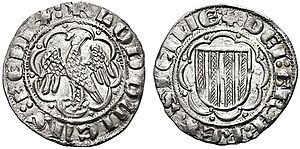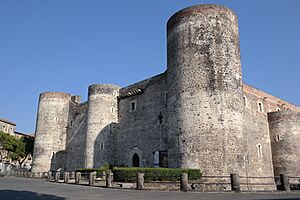Louis, King of Sicily facts for kids
Quick facts for kids Louis the Child |
|
|---|---|

Pierreale minted for Louis
|
|
| King of Sicily | |
| Reign | 15 August 1342 - 16 October 1355 |
| Predecessor | Peter II |
| Successor | Frederick IV |
| Born | 4 February 1338 Catania, Kingdom of Sicily |
| Died | 16 October 1355 (aged 17) Castello Normanno, Aci Castello |
| Burial | Catania Cathedral |
| Issue |
|
| House | Barcelona |
| Father | Peter II of Sicily |
| Mother | Elizabeth of Carinthia |
Louis the Child (born 4 February 1338 – died 16 October 1355) was the King of Sicily from 1342 until his death. Sicily was also known as "Trinacria" back then. Louis became king when he was very young, so he had a special helper, called a regent, who ruled for him until 1354. His own time as ruler was very short because he died from a terrible sickness called the plague the next year. His time as king was also filled with a difficult civil war.
Contents
Becoming King
Louis was born in Catania, a city in Sicily. His father was King Peter II, and his mother was Elisabeth of Carinthia. When Louis was born, his father immediately announced that he would be the next king. Louis was the first boy born to King Peter since his older brother, Frederick, had died.
Louis was only four years old when his father passed away in 1342. He didn't become king right away. Instead, his uncle, John of Randazzo, became his regent. A regent is someone who rules a country when the king or queen is too young or unable to rule themselves. Before he was crowned, Louis was called "successor," meaning he was next in line for the throne. On 15 September, Louis was crowned king in the cathedral of Palermo.
Early Years as King
After his coronation, Louis lived in Catania for a while. In 1344, there were talks about him marrying Constance, the daughter of Peter IV of Aragon. It was common for kings to arrange marriages for political reasons.
In 1347, Sicily signed a peace treaty with the Kingdom of Naples. Naples had claimed Sicily for itself. The treaty allowed Sicily to remain independent, but Louis had to use the title "King of Trinacria" instead of "King of Sicily." However, the Pope never officially agreed to this treaty.
After his uncle John died in 1348, Blasco II de Alagona, a nobleman from Catalonia, became Louis's new regent.
A Kingdom Divided: Civil War
In 1348, a nobleman named Matteo Palizzi returned from exile. This caused a big fight between two groups of nobles in Sicily. One group was made up of local Sicilian families, and the other group was from Catalonia (a region in Spain). These two groups started a civil war, which is a war between people of the same country. The Sicilian families were sometimes called "pro-Angevin" (meaning they supported the rulers of Naples), and the Catalan families were called "pro-Aragonese" (meaning they supported the rulers of Aragon, a kingdom in Spain).
Louis's mother sided with the pro-Naples group. During this time, Louis moved around a lot, staying in different castles and towns like Lentini, Augusta, and Castrogiovanni. In 1349, his mother died, and his older sister, Constance, took over her role in supporting Louis.
In 1350, both sides agreed to stop fighting until Louis was old enough to rule on his own. In 1352, when Louis turned fourteen, Matteo Palizzi encouraged him to declare that he would start ruling personally. But the fighting continued.
Constance Takes Charge
In 1353, Louis left Messina with his supporters, the Chiaramonte family, to stop a rebellion. Later, a riot in Messina allowed the forces of Enrico Rosso and Simone Chiaramonte to enter the city. They demanded that Louis hand over his guardian, Matteo Palizzi. Louis refused, but Matteo was found and killed. Louis managed to escape on a ship and sailed to Catania, where he joined his new allies, led by Blasco de Alagona. He moved into the Castello Ursino.
In November 1353, Louis officially made his sister Constance the new regent. Louis tried to leave Catania several times to fight his enemies, but he was not successful and had to return to the safety of the city.
Invasion and Louis's Death
In April 1354, the Neapolitans (people from Naples) invaded Sicily. They took control of Palermo and much of the island, working with the Chiaramonte family and other pro-Naples groups. Only Catania and Messina remained under Louis's control, supported by the Catalan group. Luckily for Louis, the new King of Naples, Louis I, did not send enough help to keep the invasion going. Louis of Sicily sent messages to Naples to protest the invasion and asked Peter IV of Aragon for help.
In June 1354, Louis brought back the Ventimiglia family, who were old rivals of the Chiaramonte family. He also personally led his army to take back Piazza Armerina. He continued to win battles in the western part of Sicily, taking towns like Cammarata and Trapani.
In July 1355, a terrible sickness called the bubonic plague broke out in Catania. Louis left for Messina to escape it. From Messina, he led a campaign against Palermo, but he only managed to damage the countryside. By September, he returned to Catania.
Soon after, Louis himself became sick with the plague. He moved to Aci, a castle that belonged to a relative who had recently died. Louis died there on 16 October 1355, when he was only seventeen years old. His body was taken to the cathedral of Sant'Agata and buried next to his grandfather and uncle.
Louis had two sons, Antonio and Luigi, even though he was never officially married. They were sent to Barcelona to be raised by their aunt, Eleanor, who was the queen of Aragon.
| Regnal titles | ||
|---|---|---|
| Preceded by Peter II |
King of Sicily 1342–1355 |
Succeeded by Frederick III (IV) |
See also
 In Spanish: Luis de Sicilia para niños
In Spanish: Luis de Sicilia para niños



